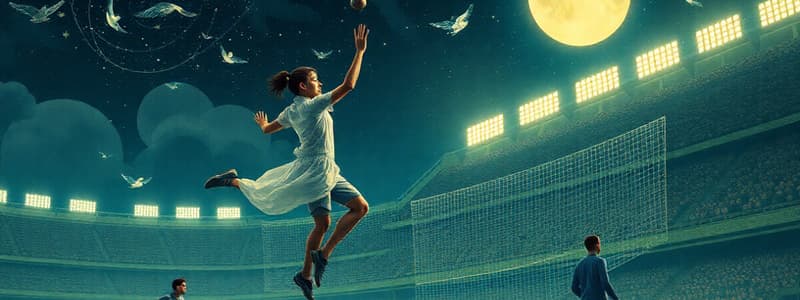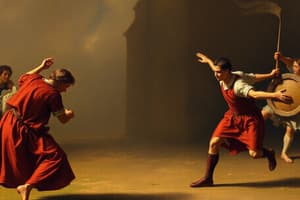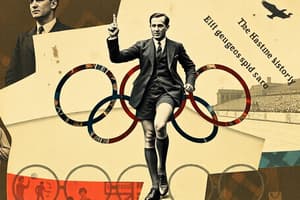Podcast
Questions and Answers
Comment la notion d'histoire du sport peut-elle être définie?
Comment la notion d'histoire du sport peut-elle être définie?
- Uniquement l'étude des athlètes célèbres et de leurs performances.
- Une science examinant l'évolution des phénomènes sportifs à travers le temps. (correct)
- Une liste de records et de statistiques sportives.
- Une simple chronologie des événements sportifs.
Quel aspect du sport est principalement mis en évidence par la notion diachronique?
Quel aspect du sport est principalement mis en évidence par la notion diachronique?
- La comparaison des différents sports pratiqués à travers l'histoire.
- La popularité croissante du sport à travers le monde.
- L'impact économique du sport sur les sociétés modernes.
- L'étude de ce qui change et de ce qui reste constant dans le sport. (correct)
Quel est le principal impact de la médiatisation sur le sport?
Quel est le principal impact de la médiatisation sur le sport?
- Elle limite l'accès au sport pour le grand public.
- Elle réduit l'importance des performances sportives.
- Elle standardise les règles et les pratiques sportives.
- Elle augmente la popularité et l'influence du sport. (correct)
Comment le sport est-il lié à la culture et au patrimoine?
Comment le sport est-il lié à la culture et au patrimoine?
Quel rôle les médias jouent-ils dans le monde du sport?
Quel rôle les médias jouent-ils dans le monde du sport?
Entre 1970 et 1980, comment le sport a-t-il évolué en termes d'impact sociétal?
Entre 1970 et 1980, comment le sport a-t-il évolué en termes d'impact sociétal?
Comment le sport est-il lié à l'histoire des pratiques et des techniques?
Comment le sport est-il lié à l'histoire des pratiques et des techniques?
Quel est l'objectif principal de l'intégration de l'éducation physique dans le système éducatif?
Quel est l'objectif principal de l'intégration de l'éducation physique dans le système éducatif?
En quoi le sport est-il lié à la discipline militaire?
En quoi le sport est-il lié à la discipline militaire?
Comment le modèle moderne de sport a-t-il été influencé par la notion de "héros du peuple"?
Comment le modèle moderne de sport a-t-il été influencé par la notion de "héros du peuple"?
Flashcards
L'histoire du sport
L'histoire du sport
La science qui retrace le passé et l'évolution d'un phénomène sportif.
Notion diachronique
Notion diachronique
Évaluer ce qui change et ce qui reste stable dans le temps.
Phénomène sportif
Phénomène sportif
Un incident ou un geste qui transforme le cours des choses, conduisant à un changement ou à la célébrité.
Sport et société
Sport et société
Signup and view all the flashcards
Sport dans l'Antiquité
Sport dans l'Antiquité
Signup and view all the flashcards
Sport moderne
Sport moderne
Signup and view all the flashcards
Années 1980-1990
Années 1980-1990
Signup and view all the flashcards
Histoire des disciplines sportives
Histoire des disciplines sportives
Signup and view all the flashcards
Figures sportives
Figures sportives
Signup and view all the flashcards
Importance des médias
Importance des médias
Signup and view all the flashcards
Study Notes
- The notes cover the history of sports, including its evolution, societal impact, and key figures.
La Notion d'Histoire (du Sport)
- History, in the context of sports, is the study of the past and the evolution of a sporting phenomenon.
- It examines the changes between two points in time, A and B.
- The diachronic approach evaluates what changes and what remains constant, considering both rupture and continuity.
- A significant sporting event or action can alter the course, leading to a change or creating a celebrity.
- An example of this is Dick Fosbury revolutionizing the high jump in 1968.
- Pierre de Coubertin revolutionized the Olympic Games through how the games are run.
- History is linked to the present, using the past to understand the current issues and reflections.
- The past is an integral part of understanding the present.
- Historically, sports were not always considered an important area of study.
- Studying sports provides insights into society, as it has become an essential element.
- The history of sport mirrors the history of society (metonymy).
- Studying sports provides a reflection of society.
- Between 1970 and 1980, there was a progressive shift where sports increasingly impacted all aspects of society.
Sport et Patrimoine
- Sports are part of the cultural heritage.
- Sports museums highlight the evolution of sports.
- When visiting a city, stadiums and club museums are often visited.
Temporalité
- The emergence of sports has occurred in different periods throughout history.
- Antiquity (700 BC to 500 AD): period of intense sporting activity.
- Ancient Greece with Athens as its center fostered the creation of the first Olympic Games (-776 BC).
- The games spread throughout the empire, including France (Nikaia = Nice).
- Cities like Olympia organized games with sports facilities near religious buildings.
- Sports were tied to religion.
- Societies that value sports are considered developed societies.
- The Romans developed sports in all cities of their empire, with festivals every two months (ludis).
- They left behind important sporting heritage like the Colosseum in Rome.
- Champion athletes, coaches, and heroes emerged as modern models.
- Sport activity declined after antiquity.
- Late 19th century: the industrial revolution in the West (1850-1914) led to modern sports.
- No Olympics or organized championships existed in 1850, and there were no standardized sports.
- Competitive international sports emerged around 1914.
- Contributing factors include modernization, urbanization, and the emergence of leisure time and inventions.
- Acceleration of sports, and media exposure existed throughout the 1980s and 1990s.
- Sports became central to society, and people began to consume sports daily.
- Nations began using sports to develop diplomatic ties (e.g., Qatar).
Contours du Sport
- Reflecting on the history of sports means considering the history of specific disciplines; each family of discipline has its history.
- It also involves the history of practices (gestures), including technical evolution to improve performance, technological advances, and cultural changes.
- A historical record of local, regional, national, and international competitions and championships exists.
- Also, a historical record of supporters, spectators, and the public interest.
- History expands the idea of sport, including the presentation in the body.
- Also, there is an inclusion of elements like the body's limits and the use of doping.
- A history of idealized bodies in advertisements, images, and notions of feminine and masculine beauty.
- The history of adventure sports includes conquests, discoveries (e.g., raids, mountain summits, and round-the-world tours).
Figures
- The history of sports focuses on individuals who have shaped and created sports, gaining notoriety and influence.
- The history includes biographies of athletes with local or international recognition.
- The role of sports promoters, agents of sports development (leaders, competition creators, journalists) is considered.
- Also, the role and the history of supporters.
- Sports are linked to military discipline, and soldiers become sports heroes; for example, Jean Boin, a runner who died in WWI, had stadiums named after him.
Importance des Médias
- Sports are staged and presented through the media, giving the sport an outlet without certain sports would not exist.
- Increased media coverage (newspapers, TV, photos) amplifies the impact of sports.
- Images create enduring impressions.
- Radio remains a medium for listening to sports events.
- Television since the 1960s has allowed viewers to follow all aspects of sports live.
- Social media platforms are used widely.
- Sports have influence in art, cinema, literature, theater, and music.
Distinction entre Éducation Physique et Sport
- Physical education is the introduction of sports into the educational system.
- Sport refers to competitive domains.
Sport et Genre
- Consideration of male and female participation, how sports have developed, and evolving opportunities for men and women.
- Gender equality is a goal for the 2024 Olympics.
- Sports like auto racing, CrossFit, equestrian, and sailing are examples where men and women compete on an equal footing.
Studying That Suits You
Use AI to generate personalized quizzes and flashcards to suit your learning preferences.




